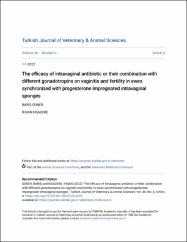| dc.contributor.author | Güner, Barış | |
| dc.contributor.author | Kısadere, İhsan | |
| dc.date.accessioned | 2023-12-28T07:19:59Z | |
| dc.date.available | 2023-12-28T07:19:59Z | |
| dc.date.issued | 2022 | en_US |
| dc.identifier.issn | 1300-0128 | |
| dc.identifier.uri | https://doi.org/10.55730/1300-0128.4228 | |
| dc.identifier.uri | https://hdl.handle.net/20.500.12462/13703 | |
| dc.description.abstract | This study was conducted with two experiments to investigate the efficacy of intravaginal antibiotic or their combination with different gonadotropin use on vaginitis and the fertility in Berrichon ewes. All ewes (n = 106) were synchronized with intravaginal sponges containing 60 mg medroxyprogesterone acetate for 14 days. For the first experiment, ewes (n = 50) received 50 mg enrofloxacin (TRT) to sponge prior to insertion or received no treatment to sponge (CON) during nonbreeding season. For the second experiment, ewes (n = 56) were randomly assigned to one of the four groups (TRT-E; TRT-G; CON-E; CON-G) according to the presence of antibioterapy (TRT or CON) to sponge and variety of gonadotropins at sponge withdrawal (equine chorionic gonadotropin-eCG; E, 500 IU) or 24 h later after sponge withdrawal (gonadotropin-releasing hormone-GnRH; G, 10 ??g) during breeding season. Vaginitis and odour were scored according to amount/aspect and odour of discharge. The addition of enrofloxacin did not change the vaginitis score (0.65 ?? 0.52 vs. 0.79 ?? 0.67, p = 0.25) and vaginal discharge odour score (2.07 ?? 0.71 vs. 2.25 ?? 0.84, p = 0.26) in both experiments. Oestrus response and pregnancy rate were 88%; 56% for TRT and 80%; 40% for CON in the first experiment (p > 0.05). These parameters were 92.3%; 69.2% for TRT-E, 86.7%; 53.3% for CON-E, 71.4%; 7.1% for TRT-G, and 64.3%; 21.4% for CON-G group. The pregnancy rate was higher (p = 0.002) in TRT-E group than TRT-G and CON-G. Additionally, oestrus response (p = 0.05) and pregnancy rate (p = 0.0001) were higher in eCG group (89.2%; 60.7%) than GnRH group (67.8%; 14.3%) in the second experiment. In conclusion, local antibiotherapy with enrofloxacin did not alter vaginitis score and fertility. However, GnRH reduced the oestrus response and pregnancy rate to eCG. | en_US |
| dc.language.iso | eng | en_US |
| dc.publisher | Scientific and Technological Research Council Turkey | en_US |
| dc.relation.isversionof | 10.55730/1300-0128.4228 | en_US |
| dc.rights | info:eu-repo/semantics/openAccess | en_US |
| dc.rights.uri | http://creativecommons.org/licenses/by/3.0/us/ | * |
| dc.subject | Enrofloxacin | en_US |
| dc.subject | Ewes | en_US |
| dc.subject | Fertility | en_US |
| dc.subject | GnRH | en_US |
| dc.subject | Vaginitis | en_US |
| dc.title | The efficacy of intravaginal antibiotic or their combination with different gonadotropins on vaginitis and fertility in ewes synchronized with progesterone impregnated intravaginal sponges | en_US |
| dc.type | article | en_US |
| dc.relation.journal | Turkish Journal of Veterinary & Animal Sciences | en_US |
| dc.contributor.department | Veteriner Fakültesi | en_US |
| dc.contributor.authorID | 0000-0001-6414-6752 | en_US |
| dc.contributor.authorID | 0000-0003-0732-0464 | en_US |
| dc.identifier.volume | 46 | en_US |
| dc.identifier.issue | 4 | en_US |
| dc.identifier.startpage | 575 | en_US |
| dc.identifier.endpage | 581 | en_US |
| dc.relation.publicationcategory | Makale - Uluslararası Hakemli Dergi - Kurum Öğretim Elemanı | en_US |




















